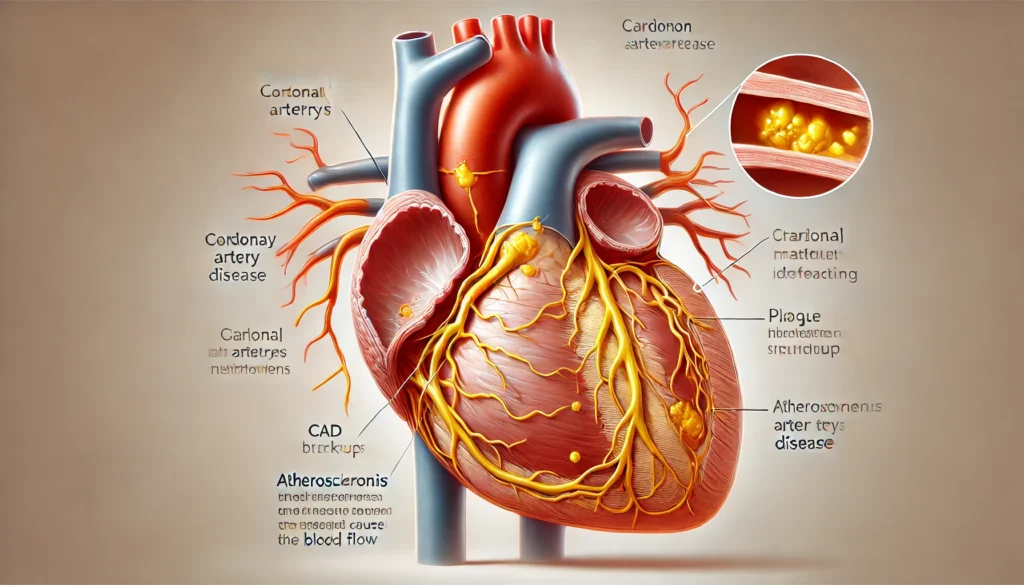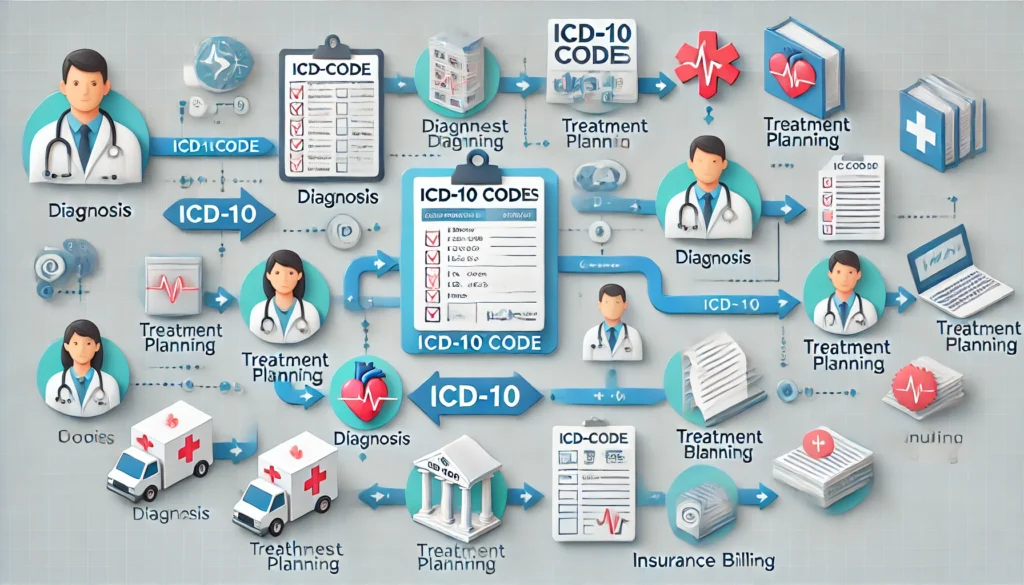Coronary artery disease (CAD) is one of the most prevalent cardiovascular conditions, and its correct diagnosis and treatment are crucial for patient outcomes. A key component of managing CAD is ensuring the appropriate coding of the condition, particularly using the ICD-10 (International Classification of Diseases, 10th Revision) system. In this post, we will explore the ICD-10 code for coronary artery disease, why it matters, and how it is used in medical practice.
Discover 6 Essential ICD-10 Codes for Coronary Artery Disease.
Table des matières
- What is Coronary Artery Disease (CAD)?
- Overview of ICD-10 (International Classification of Diseases, 10th Revision)
- ICD-10 Code for Coronary Artery Disease
- Other Related ICD-10 Codes for CAD Conditions
- How the ICD-10 Code for CAD is Used in Medical Practice
- Common Errors and Pitfalls in ICD-10 Coding for CAD
- Frequently Asked Questions (FAQ)
- Conclusion
What is Coronary Artery Disease (CAD)?
Coronary artery disease, also known as ischemic heart disease, occurs when the coronary arteries—the blood vessels supplying the heart—become narrowed or blocked due to a buildup of plaque. This condition impedes blood flow to the heart muscle, often leading to chest pain (angina), shortness of breath, and in more severe cases, heart attacks or heart failure. CAD is primarily caused by atherosclerosis, a condition where fatty deposits build up inside the arteries over time.
Common risk factors for CAD include:
- High blood pressure
- High cholesterol levels
- Smoking
- Obesity
- Diabetes
- Family history of heart disease
Symptoms can vary depending on the severity of the disease, but chest pain, fatigue, and irregular heartbeats are common indicators. For many patients, CAD may go undiagnosed until more serious events, such as a heart attack, occur.

Overview of ICD-10 (International Classification of Diseases, 10th Revision)
ICD-10 is a global system for classifying and coding diseases and health conditions. It was developed by the World Health Organization (WHO) and is used by healthcare providers, insurers, and researchers worldwide to ensure consistent diagnosis, treatment, and reporting. The system includes a wide range of codes that cover everything from infectious diseases to chronic conditions like CAD.
The ICD-10 coding system is vital in the modern healthcare landscape, as it plays a significant role in:
- Medical billing and reimbursement
- Tracking disease prevalence and health trends
- Enabling accurate patient records and facilitating communication between healthcare providers
Each code in the ICD-10 system represents a specific diagnosis or health condition. For coronary artery disease, there is a range of codes that can be used, depending on the specifics of the disease and its manifestations.

ICD-10 Code for Coronary Artery Disease
The primary ICD-10 code used to diagnose coronary artery disease is I25.1 – Atherosclerotic heart disease of native coronary artery. This code specifically refers to CAD caused by atherosclerosis in the coronary arteries. It is essential for accurate diagnosis and is widely used in both inpatient and outpatient settings.
However, CAD can present in different forms, which means there are variations of ICD-10 codes that might be used to specify the condition more precisely. Some of the common ICD-10 codes for coronary artery disease include:
- I25.10 – Atherosclerotic heart disease of unspecified type: Used when the type of CAD is not specified.
- I25.11 – Atherosclerotic heart disease of the coronary artery bypass graft(s): Used when the patient has undergone coronary artery bypass surgery, but the grafts are affected by atherosclerosis.
- I25.2 – Old myocardial infarction: This code is used when CAD has led to a previous heart attack (myocardial infarction) and the patient now has a history of that event.
- I25.9 – Chronic ischemic heart disease, unspecified: Used when CAD has resulted in chronic ischemia, but the details of the condition are unclear or unspecified.
Other Related ICD-10 Codes for CAD Conditions
Aside from the primary ICD-10 codes for CAD, there are other relevant codes that are used when a patient with coronary artery disease develops complications or related conditions. Some of these codes include:
- I21.9 – Acute myocardial infarction, unspecified: This code is used if a patient with CAD suffers from an acute heart attack, and no specific details are available about the infarction.
- I21.01 – ST elevation (STEMI) myocardial infarction, anterior wall: A more specific code used when the heart attack involves the anterior wall of the heart.
- I20.0 – Unstable angina: Used for CAD patients experiencing severe chest pain due to the temporary reduction in blood flow to the heart.
These additional codes help to provide a clearer picture of the patient’s condition, which in turn influences treatment decisions and the accuracy of billing and insurance claims.

How the ICD-10 Code for CAD is Used in Medical Practice
The ICD-10 code for coronary artery disease is essential for multiple aspects of patient care and healthcare management. It is used by healthcare providers to document a patient’s condition in their medical records, ensuring that the appropriate treatment and interventions are applied.
Beyond diagnosis and treatment, ICD-10 codes play a crucial role in the administrative and financial aspects of healthcare. Accurate coding is necessary for:
- Medical billing: ICD-10 codes help determine the billing process for both inpatient and outpatient care.
- Insurance reimbursement: Healthcare providers rely on the correct use of ICD-10 codes to ensure that they are reimbursed properly for the care they provide.
- Research and data collection: Standardized coding helps track the prevalence of CAD and other diseases, which aids in public health monitoring and research efforts.
Healthcare providers, including cardiologists, general practitioners, and medical coders, must ensure that the appropriate ICD-10 code is used to avoid delays in treatment or claims rejection by insurance companies.
Common Errors and Pitfalls in ICD-10 Coding for CAD
Even though ICD-10 codes are standardized, common mistakes can occur during the coding process. Some of the most frequent errors in CAD coding include:
- Misclassifying the type of CAD: For instance, incorrectly using a code for unstable angina when the patient has stable angina.
- Not specifying the coronary artery involved: Some CAD codes require specifying the artery affected, such as using I25.110 for the left coronary artery.
- Failure to update the code: As CAD progresses, the code may need to be updated. A patient who initially had stable angina may later develop unstable angina or myocardial infarction, requiring a change in coding.
To avoid these mistakes, healthcare professionals should stay current with the latest ICD-10 coding guidelines and undergo regular training on accurate coding practices. Misuse of codes can lead to incorrect diagnoses, delayed treatments, or issues with insurance claims.

Frequently Asked Questions (FAQ)
The primary ICD-10 code for coronary artery disease is I25.1, which refers to atherosclerotic heart disease of the native coronary artery. Additional codes like I25.10 (unspecified type) and I25.11 (coronary artery bypass grafts affected) may be used depending on the specifics of the condition.
The correct ICD-10 code for CAD depends on the specifics of the patient’s condition. If the type of CAD is not specified, I25.10 is used. If the patient has a history of heart surgery like bypass, you might use I25.11. Always refer to the patient’s medical history and symptoms to select the appropriate code.
No, there are multiple ICD-10 codes for different types of CAD. For example, I25.9 is used for chronic ischemic heart disease, whereas I21 codes are used for myocardial infarctions related to CAD. The code should reflect the most accurate diagnosis for the patient.
Incorrect coding can lead to delays in treatment, insurance claim rejections, and potential mismanagement of the condition. It is essential to use the correct ICD-10 code to ensure accurate medical records, proper billing, and appropriate care.
Conclusion
The ICD-10 code for coronary artery disease, primarily I25.1, is a critical component of diagnosing, documenting, and treating this widespread condition. Accurate coding ensures that patients receive the right care, healthcare providers are properly reimbursed, and data is consistently tracked for research and policy-making purposes. Whether you’re a medical professional, coder, or patient, understanding and using the correct ICD-10 codes is vital for optimal healthcare delivery.
1 réflexion au sujet de « What is the ICD-10 code for coronary artery disease? »